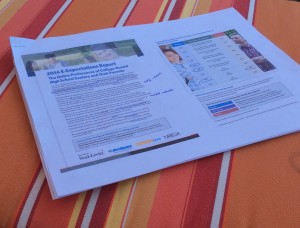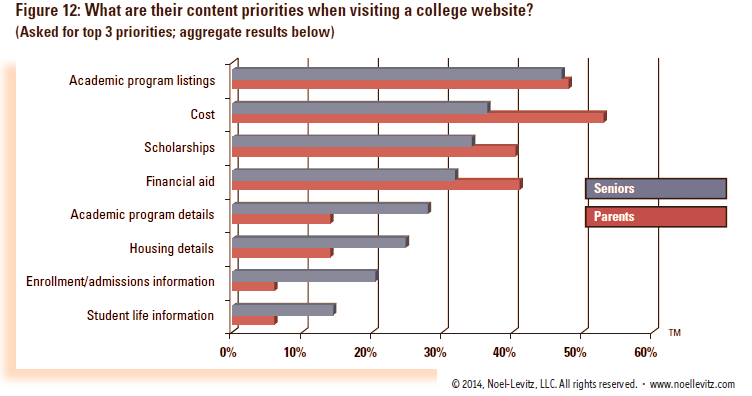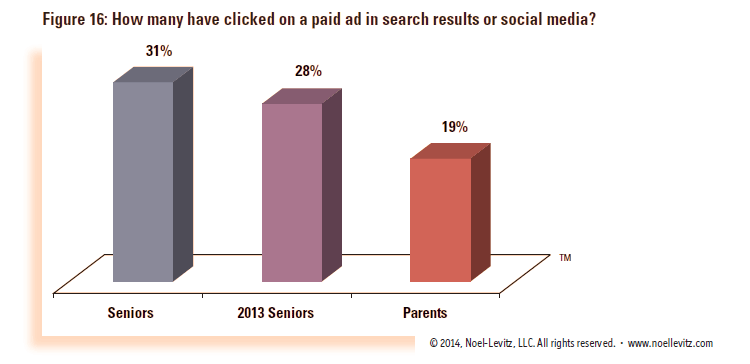 The brand new Noel-Levitz report on the E-expectations of college bound seniors and their parents has been released this morning.
The brand new Noel-Levitz report on the E-expectations of college bound seniors and their parents has been released this morning.
I had the opportunity to spend time reviewing it before its official release as Stephanie Geyer from Noel-Levitz emailed me a copy of the final report last week, so YOU get a chance to know what’s in it before everybody else :-)
With the extra time, I was able to identify the most interesting points in this 20-page report (PDF).
As you know, this yearly E-Expectations research always provides very interesting insights on the preferences of college-bound high school students when it comes to the college admission process.
This year, the results are based on a phone survey conducted in March 2014 with a sample of a 1,000 college-bound seniors and 533 parents, so the data is fresh and relevant to any institution recruiting prospective college-aged students in the US.
I’ve identified 5 interesting insights from the full 20-page report.
1) Your school website is still the ONE for prospective students… and their top influencers: their parents
When it’s time to make a decision for students and parents, the college website is always the most popular influential college search resource – before college emails, college planning sites, college rating sites, college ranking magazines, Facebook & Twitter posts from colleges.
For 77% of seniors (75% in 2013) and 69% of parents, your school website is an influential source of information.

And, the good news is your website is also considered as one of the most reliable sources of information for 97% of seniors and 89% of parents.
TAKE-AWAY #1:
If your website doesn’t provide reliable and useful information to prospective students yet, fix your it ASAP. It doesn’t make sense to spend resources and time on other digital marketing tactics, if this core component doesn’t perform well.
2) Stop hiding – on your website – the price to pay
That’s one of the content priorities for the majority of parents, and the 2nd most popular topic for seniors just after academic program listings.
As you can see, the money question is front and center for most when they visit your website as reflected in 3 of the top 4 content priorities for students and parents.

TAKE-AWAY #2:
Money talks might not be fun, but this is what’s top of mind for your prospective students and their biggest influencers, their parents. So, stop having them chase for this information (it’s kind of mandatory anyway), and earn points by providing clear information about costs, scholarships and financial aid while showing the value and benefits of an education at your institution on these pages. Treat your costs & financial aid web pages as the important landing pages they have become when they are found through search. They should not be dead ends, but hubs to present your institution value proposition and start prospective students and parents in a website journey to discover what your school can offer.
3) Your college website and emails should work on all connected devices: mobile and desktop
90% of seniors (vs. 78% in 2013) have access to a mobile device and close to 70% of them use a smartphone – a 20-percentage-point increase from 2013.
A bit more than 50% don’t even have access to a PC and 40% use their mobile device all the time.
65% (47% last year) check email on mobile at least once a day.

Yet, more than 85% of 2014 seniors (vs. 82% in 2013) prefer to look at college websites on a desktop computer.
TAKE-AWAY #3:
How do you make everybody happy no matter what device they use? You go responsive! The responsive web design approach has definitely helped institutions catch up with the multiplication of connected devices (we’ve done our part to help with our course on responsive web design for Higher Ed). If your school website doesn’t work well on smartphones AND desktops, you definitely need to fix it ASAP.
4) Social has become SO… Visual
Facebook is far from dead for high school seniors, but alive and kicking with more than 70% using it.
YouTube is not far – widely used by more than 70% as well. Its usage more than doubled compared to last year where only 30% were reporting using it. While this increase might be explained by the deeper integration between the other social platforms and YouTube, it definitely shows how important online videos have become for prospective college students.
Instagram and Snapchat have also known important usage increase as well over the past year.
While Google+ (which is often said in higher ed to be a dead zone) is now used by more than 30% of HS seniors, the new darling of higher ed marketers, LinkedIn, is definitely NOT on the radar of most prospective students.

Yet, it’s not because prospective students use a social media platform that they will automatically use it in their college search. Some do, but not as many as shown by these results:
- 51% (41% in 2013) have visited a college’s Facebook page
- 37% (25% in 2013) follow a college on Twitter
TAKE-AWAY #4:
While social is not seen as an influential resource in college search by many according to the report, it has its place in the marketing mix of your school. As I often tell your colleagues taking my course on Social Media Marketing for Higher Ed, focus your efforts on meaningful yet engaging visuals (photos & videos) on these channels to get their attention and start to build a relationship with them.
5) Search and Social Advertising is the new black
Maybe, it’s the overwhelming amount of content now available online, but almost a third (31%) of high school seniors have clicked on ads they saw in search results or on social media platforms.
45% of the students (49% in 2013) who clicked did it on a Google ad and 30% on Facebook (24% in 2013).

While the large majority of the students who clicked the ad had a look at the landing page, less than 10% filled out a form to request more information.
TAKE-AWAY #5:
It’s time to rethink your approach to digital advertising and search engine optimization. Some institutions have started to do it. That’s why we have incorporated advertising on Google and Facebook in the curriculum of our online course on higher ed SEO.
But, don’t forget that the ad itself is just the beginning. If you really want to make it count beyond brand recognition, it’s important to optimize your landing pages.
What do YOU think?
These top insights don’t cover all the points in the report as I’ve chosen to focus on the most interesting findings for this year.
If you’ve read the report, what did YOU find the most surprising?
Tell us by posting a comment!




RT @cararousseau: RT @karinejoly: Which social media platforms do prospective students & parents use? http://t.co/eqPa0H1q1O #hesm http://t…
RT @cararousseau: RT @karinejoly: Which social media platforms do prospective students & parents use? http://t.co/eqPa0H1q1O #hesm http://t…
RT @karinejoly: Is your #highered website RESPONSIVE yet? Prospective students & their parents expect it: http://t.co/dmbYTfFRMz http://t.c…
RT @karinejoly: Which social media platforms do prospective students & parents use? http://t.co/Tm5Fa1DXQ7 #hesm #casesmc #sachat http://t.…
RT @karinejoly: Is your #highered website RESPONSIVE yet? Prospective students & their parents expect it: http://t.co/dmbYTfFRMz http://t.c…
RT @karinejoly: Which social media platforms do prospective students & parents use? http://t.co/Tm5Fa1DXQ7 #hesm #casesmc #sachat http://t.…
RT @karinejoly: Which social media platforms do prospective students & parents use? http://t.co/Tm5Fa1DXQ7 #hesm #casesmc #sachat http://t.…
RT @karinejoly: Which social media platforms do prospective students & parents use? http://t.co/Tm5Fa1DXQ7 #hesm #casesmc #sachat http://t.…
2014 Students & Parents E-Expectations Noel-Levitz Report: Top 5 insights for #highered & #hesm http://t.co/VHzQK324bp via @karinejoly
RT @karinejoly: Which social media platforms do prospective students & parents use? http://t.co/Tm5Fa1DXQ7 #hesm #casesmc #sachat http://t.…
RT @lexinet701: 2014 Students & Parents E-Expectations Noel-Levitz Report: Top 5 insights for #highered | http://t.co/yZcX62s7Z3 http://t.…
One question I found myself asking after Stephanie shared the 2013 report at HEWEB was “why do so many students prefer desktop to mobile browsing for college websites?” We can speculate that they would if we gave them a better experience, but I’d love to see a question added to the survey to hear it straight from the horse’s mouth.
What if reasons like “because I want a bigger screen for serious and important stuff like college websites” or “because I can concentrate better when I’m on my desktop” are more of a factor than “because college websites suck on mobile”?
RT @karinejoly: Which social media platforms do prospective students & parents use? http://t.co/Tm5Fa1DXQ7 #hesm #casesmc #sachat http://t.…
RT @karinejoly: What’s the top INFLUENTIAL channel for prospective students? Sorry, it’s not Twitter http://t.co/yue4vnKwYx #casesmc http:/…
RT @karinejoly: What’s the top INFLUENTIAL channel for prospective students? Sorry, it’s not Twitter http://t.co/yue4vnKwYx #casesmc http:/…
RT @karinejoly: What’s the top INFLUENTIAL channel for prospective students? Sorry, it’s not Twitter http://t.co/yue4vnKwYx #casesmc http:/…
RT @karinejoly: What’s the top INFLUENTIAL channel for prospective students? Sorry, it’s not Twitter http://t.co/yue4vnKwYx #casesmc http:/…
2014 Students & Parents Expectations Noel-Levitz Report: Top 5 insights for #highered & #hesm http://t.co/fsBy6owlON #college #recruiting
What students and parents expect from your web/social presence: top 5 insights for #highered & #hesm http://t.co/myUNKZgYjR via @karinejoly
RT @karinejoly: UPDATED: top 5 insights from 2014 e-Expectations Report with public PDF download link: http://t.co/SsDBysRVTN #hesm http://…
RT @karinejoly: UPDATED: top 5 insights from 2014 e-Expectations Report with public PDF download link: http://t.co/SsDBysRVTN #hesm http://…
RT @karinejoly: UPDATED: top 5 insights from 2014 e-Expectations Report with public PDF download link: http://t.co/SsDBysRVTN #hesm http://…
RT @karinejoly: UPDATED: top 5 insights from 2014 e-Expectations Report with public PDF download link: http://t.co/SsDBysRVTN #hesm http://…
2014 Students & Parents E-Expectations Noel-Levitz Report: Top 5 insights for #highered & #hesm http://t.co/vmFiEnvOLR
RT @karinejoly: Which social media platforms do prospective students & parents use? http://t.co/Tm5Fa1DXQ7 #hesm #casesmc #sachat http://t.…
RT @karinejoly: Which social media platforms do prospective students & parents use? http://t.co/Tm5Fa1DXQ7 #hesm #casesmc #sachat http://t.…